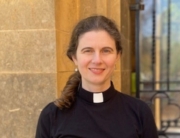
Easter 3: 5 May 2019
The Very Rev’d Frank Nelson
Psalm 116: 11-18
Revelation 2: 1-11
Acts9:22-31
“Angels blowing trumpets! Monsters rising from the deep! Lakes of fire and rivers of blood! Ah, yes – the book of revelation. There is nothing like it anywhere else in the New Testament. It certainly is the only book to feature dragons (12:3-13:10), giant bugs (9:3-11), and airborne horses (6:2-8; 19:11-12).
“Revelation is a book to excite the senses. The Bible does not often tell us what color things are, but here everything is red, purple, yellow, blue, green, gold! It is also a noisy book, rumbling with the din of battle and the crash of thunder. Earth echoes with the wailing of the damned; heaven rings with songs and shouts of the saved. And those trumpets! There is hardly a moment’s peace. No, wait – there are a thousand years of peace, but that’s just three verses (20: 4-6) and then all hell breaks loose (literally). The imagery is fantastic: buildings and furniture made of gems, and a menagerie of creatures like something Dr Seuss might have thought up after a sleepless night reading Stephen King: the locusts wear armor like horses (9:7-9), and the horses have serpents for tails. And what’s this thing that is part leopard, part bear, and part lion but lives in the sea (13:1-2)?”
These are the opening words of his chapter on the Book of Revelation written by professor of New Testament Mark Allan Powell in his book “Introducing the New Testament.”[1] And guess what, students of EfM, Education for Ministry, a seminar group that meets weekly here at the Cathedral, get to study both Powell’s book and that of Revelation.
Tonight and the next two Sunday nights our first readings come from this extraordinary and most unusual book. It’s a book which has been the happy hunting ground for generations of Christians, especially those who, often with limited education, choose to read it without any knowledge of the type of literature or reference to those who do have some background and insights. At least six times in my life time people have calculated the exact date of the end of the world by referring to Revelation. I am thankful indeed that each of those dates has come and gone, and the sun has risen and set the following day.
So what is this book and how should we read it? First we should note the book is something like a letter – it begins and ends like a letter and is meant to be read by seven churches, perhaps a circular letter to the churches in what was then Asia Minor, now Turkey. If it is the content may be intended to address specific situations in those churches each in their particular city. Second it is a book of prophecy. Like the prophetic books of the Old, or First, Testament, it claims to be passing on the direct word of God – sometimes in strange and outlandish ways, including using visions and symbolic language. It contains colorful warnings and exhortations of what God is going to do. And it is a type of literature known as apocalyptic – practically unknown to us today, but quite common in the early New Testament times. Apocalyptic literature often has the prophet, the seer, transported in fantastic visions which are interpreted by angels. There is much use of symbolism involving bizarre creatures and mysterious events. Usually apocalyptic writing is dualistic – that is to say, the world is described as having clear distinctions between good and evil. So we should expect to find devils pitted against angels, saints pitted against sinners – in a face-off with one another.
Powell suggests there are three basic ways in which to read a book like Revelation. Firstly as historical – in which case we need to have an understanding of when it was written, to whom and what was happening at the time. Then there is the idealist approach – looking for universal themes and symbols, which provide insight and meaning into any and every time and place. And finally there is the futurist approach where the book is understood to provide reference to exact time and place and events in the future.
If we take tonight’s passage, which includes two of the seven letters to the churches, we can see these different approaches working out something like this. The historical approach says that this letter was addressed to the church in Ephesus, probably about 95AD. In this case we would try to find out all we can about the church in Ephesus at this time. We know that Ephesus was the most important city of the Roman province of Asia, and that St Paul spent some years there (Acts 19). We would read carefully the Epistle to the Ephesians noting that some of what is written there seems to support the condemnation of the so-called Nicolaitan teachings and practices. If we approached the letters from an idealist angle then we would expect to find things that are common to all churches at any time – and there is some truth in that. We all know what it is like to have ‘abandoned, or lost, our first love’ for Christ (Rev 2:4). And if we took a futurist approach we would find in the seven letters eras of the future church such as those portrayed in some commentaries (the Scofield Reference Bible being one of them). In this interpretation the church in Ephesus represents the first apostolic church – those churches founded in the very early days which trace their origins back to one of the actual Apostles of Jesus. Smyrna represents the next period when the church was persecuted; Pergamum that time when Rome proclaimed Christianity as the state religion; Thyatira the corrupt mediaeval church and so on down to the modern lukewarm and, at least to some, wishy-washy, church represented by Laodicea.
I suspect that there is something of value to be found in all three of these different ways of reading and interpreting the seven letters, and Revelation as a whole. But we should, at the very least, acknowledge that this book is a complex one presenting us with a form of literature with which we are not familiar.
For my own part I have always leaned towards seeing Revelation as a book written in code to encourage Christians to remain faithful and true to God especially in difficult times – those of hardship and persecution. It is a book to encourage people who suffer because of their faith. It is a book that brings us back to the worship of the one we believe to have been raised from the dead, and whom we proclaim as the risen Lord Jesus, the Christ of God.
As we listen to the Cathedral Choir singing the Easter Anthem “O sons and daughters let us sing”, which tells the story of that first Easter Day, it may be of interest to know something about the man who arranged this version of this 17th century French tune. Born in 1869 Henry Walford Davies was an English composer, organist and educator. He held positions at the Temple Church and Windsor Chapel. During the First World War he joined the fledgling Royal Air Force and composed the ‘Royal Air Force March Past’, music still used to this day and which you will know well. I have been unable to find a date for the composition of tonight’s arrangement, but, given what I have just said about apocalytic writing, think it not too far-fetched that this lovely Easter music may have been composed during the dark days of the War. If this is the case, and I’d love to hear from those who know, it could be seen as a sort of apocalyptic music of encouragement to those pitted against each other in the mud and slaughter of the battlefields.
Whether there is any truth in my theory, the words
and music of the anthem take us back to the first Easter Day and St John’s
version of how the disciples slowly came to realize that Jesus had indeed been
raised from the dead. Like them we continue, on this most holy of days, our
hearts and voices raise to God in laud and jubilee and praise, singing
Alleluia, Alleluia!
[1] Powell, Mark Allan: Introducing the New Testament. A Historical, Literary and Theological Survey. 2009. Baker Academic. Grand Rapids. I draw heavily on this book for this sermon, quoting freely from it.



